If you are wondering why I chose this specific date to take a long break, this final “lesson” had to be written one last time. To walk away without acknowledging the events leading up to the unnecessary massacre of four innocent students would be so very wrong.
And so…
People may wonder if I have grown tired of posting this article on this date every year. The simple answer is this … I can’t ignore it and neither should you. It was and remains one of our nation’s darkest days, so I am no more tired of posting it than those four young students are tired of sleeping in their graves.
It took half a century to transform Kent State from an obscure teachers college into the second largest university in Ohio, with 21,000 students and an impressive array of modern buildings on its main campus.
But it took only thirteen seconds to convert the traditionally conformist campus into a bloodstained symbol of the rising student rebellion against the Nixon Administration and the war in Southeast Asia.
“Thirteen seconds of gunfire at a relatively unknown campus in northeastern Ohio ended the lives of four young people, and permanently altered the lives of countless others.
“The victims’ families, injured survivors, guardsmen, eyewitnesses, and politicians were immediately and directly affected. Many Americans who were shocked by the shootings began to see domestic turmoil in a different light. Our society, deeply divided before the Kent State incident, was in its aftermath completely polarized.”
J. Gregory Payne
====================================================================
Thursday, April 7, 1970
California Governor Ronald Reagan, asked to comment about police using excessive force to suppress a student protest at Berkeley, says, “If it takes a bloodbath, let’s get it over with. No more appeasement.”
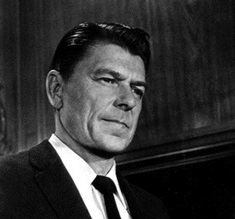
Thursday, April 28, 1970
Vice President Spiro Agnew lashed out at what he called the overly permissive attitude of university officials and faculty toward the student protest movement.
“One modest suggestion for my friends in the academic community. Next time a mob of students, waving their non-negotiable demands, starts pitching bricks and rocks at the student union, just imagine they are wearing brown shirts or white sheets–and act accordingly. It’s better to have a confrontation than a cave-in.”
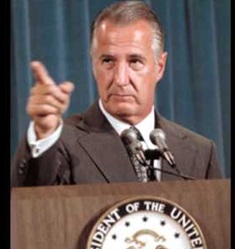
Thursday, April 30, 1970
President Richard Nixon announces to the nation that an “incursion” into Cambodia has been launched by United States combat forces. Nixon had been elected president in 1968 claiming to have a “secret plan” to end the war in Southeast Asia. But the revelation that he was in fact escalating it with the illegal bombing of what had been a peaceful non-combatant nation was more than Americans could bear.
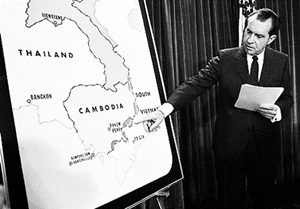
>==================================================================
Friday, May 1, 1970
Noon
As a symbolic protest to President Nixon’s decision to send troops into Cambodia, about 500 students gather to bury a copy of the United States Constitution, declaring that it had been “murdered” when troops had been sent into Cambodia without a declaration of war or consultation with Congress.
The event takes place near the Victory Bell, normally rung to celebrate Kent football victories. There is no disorder. The meeting closes with a call for another rally at noon Monday to discuss the attitude of the university administration toward the Cambodian incursion and toward other student demands, including abolition of the ROTC program
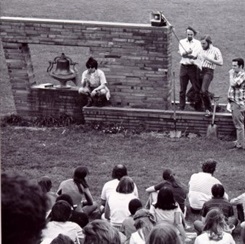
3:00 p.m.
Black United Students hold a rally attended by approximately four hundred persons and discuss issues of the Black community and incidents at Ohio State University. Kent State University President Robert White decides the situation at Kent is calm and leaves on a planned trip to Iowa.
Late Afternoon
Speaking at the Pentagon, Nixon says, “You know, you see these bums, you know, blowin’ up the campuses. Listen, the boys that are on the college campuses today are the luckiest people in the world, going to the greatest universities, and here they are, burnin’ up the books, I mean, stormin’ around about this issue, I mean, you name it – get rid of the war, there’ll be another one.”
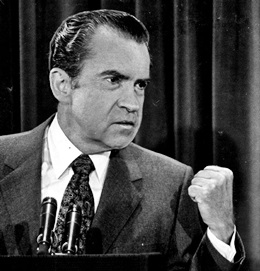
11:00 p.m.
On one of the first warm nights of spring, several people gather in the streets in the Kent bar area and close the street to traffic. Most of the students present remain in the bars, many watching the NBA basketball playoffs.
Many among the crowd are not Kent State students. A local motorcycle gang performs tricks on their bikes and ignites a bonfire. Some of those assembled begin to trash stores and deface property. There is no effort by the Kent Police Department to break up the crowd.
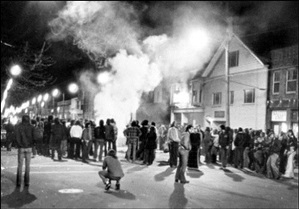
Saturday, May 2, 1970
12:30 a.m.
The crowd becomes more boisterous. After being informed of the events, Kent Mayor Leroy Satrom declares a “state of emergency,” orders the bars closed, and directs the police to clear the area. The action angers individuals present in the bars, many of whom are unaware of the action taking place outside, and results in a dramatic increase in the number of people in the area and a heightening of their mood of hostility.
12:47 a.m.
Believing that radicals and the SDS had initiated the disturbance, Mayor Satrom calls Governor James A. Rhodes and informs his Administrative Assistant of the situation. In response, the Ohio National Guard directs an officer to study the situation at Kent.
1:00 a.m.
After emptying the bars, the Kent Municipal Police attempt to drive the group away from the downtown area and toward the campus of Kent State University. The Kent State University Campus Police offer little assistance in this effort.
The crowd finally breaks up after a freak incident involving an individual hanging from a traffic light. Damage estimates are initially set at $50,000, a figure later reduced to $15,000. Fifteen persons, all from Ohio, are arrested.
The President’s Commission on Campus Unrest offered the following summary of the events and feelings present among those involved:
“The pattern established on Friday night was to recur throughout the weekend. There were disorderly incidents; authorities could not or did not respond in time to apprehend those responsible or to stop the incidents in their early stages; the disorder grew; the police action, when it came, involved bystanders as well as participants; and, finally, the students drew together in the conviction that they were being arbitrarily harassed.”
10:00 a.m.
Mayor Satrom is informed by Police Chief Ed Thompson that his intelligence officers have noticed new faces in Kent, and have reports of an impending arrival of carloads of SDS students. There are threats to merchants that damage will be done to their businesses if anti-war messages are not put in their windows.
The police guard the water supply of the city after learning of a report that it would be spiked with LSD. Mayor Satrom establishes a city curfew of 8:00 p.m. to 6:00 a.m. and a conflicting 11:00 p.m. to 6:00 a.m. curfew for the campus. This decision results in much misunderstanding in the days to follow.
5:00 p.m.
After assessing the situation, Mayor Satrom calls in the National Guard. Kent State University officials are unaware of this decision.
7:30 p.m.
Approximately six hundred people, including individuals who are not students, gather on the Commons at Kent State University and attempt to burn the ROTC building. There are numerous futile attempts and many of those gathered leave the area.

8:45 p.m.
The ROTC building is ablaze. (The identity of who actually set the ROTC building on fire is still an unresolved issue.)
9:00 p.m.
The Kent Municipal Fire Department arrives to fight the fire, but is forced to abandon its efforts as the crowd slashes hoses and stone the firemen. The Kent State Campus Police do not offer protection for the firemen nor do they attempt to disperse the crowd.
10:00 p.m.
The Ohio National Guard arrives in Kent and blocks the crowd’s path into the city. Presence of the Guard surprises University officials and students. The Guard maintains control of the situation, which is characterized by rock throwing and at least one bayoneting.
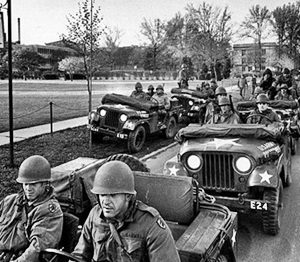
Sunday, May 3, 1970
10:00 a.m.
Ohio Governor James A. Rhodes, involved in a Republican primary battle for the party’s U.S. senatorial nomination, arrives in Kent and announces at a news conference, “They are the strongest, well-trained militant revolutionary group that has ever assembled in America They’re worse than the brownshirts and the Communist element and the night riders and the vigilantes. They are the worst type of people that we harbor in America. We’re going to use every weapon possible to eradicate the problem.”

Some leaders interpret the governor’s statement to mean martial law has been declared, but no decree had actually been issued.
Afternoon
After Rhodes’ news conference, university officials confer with guard officials and incorrectly conclude that Rhodes’ statement forbade any rallies or gatherings. Twelve thousand leaflets are prepared announcing this information, but because of poor methods of distribution, most Kent State students did not receive the leaflet until after the shooting incident on Monday.
Late Afternoon
One solitary Guardsman stands quietly alone, a lilac in his gun barrel. Allison Krause is struck by this compassionate scene and begins to converse with him.
Disturbed at the pleasant rapport one of his men was enjoying with the students, an officer slowly strolls over and places his arm around the Guardsman’s shoulder and begins to question the young man.
Officer: Doesn’t your division have target practice next week, Meyers?
A: Yes, sir.
Officer: Are you going there with that silly flower?
A: No, sir.
Officer: Then what is it doing in your rifle barrel?
A: It was a gift, sir
Officer: Do you always accept gifts, Meyers?
A: No, sir.
Officer:Then why did you accept this one? What are you going to do with it, Meyers?
The Guardsman feebly begins to remove the lilac
Officer: That’s better Meyers. Now straighten up and start acting like a soldier and forget all this peace stuff.
Realizing the officer would merely throw the lilac away, Krause grabs it from his hand and gives him a look of disgust, but he turns his back.
As the officer walks away, Krause calls after him with words that will become eerily prophetic the following day:
“What’s the matter with peace? Flowers are better than bullets!”
Less than 24 hours later, Allison Krause will be dead.
8:00 p.m.
A crowd begins to gather on the Commons. As the group grows, Guard officials announce the immediate enforcement of a new curfew. The Guard begins attempts to disperse the crowd. Many students who are unaware of the new curfew become involved as the Guard sweeps through campus.
8:45 p.m.
Officials determine the campus curfew will go into effect. The crowd is dispersed from the Commons area with tear gas.
9:00 p.m.
Students attempt to demonstrate that the curfew is unnecessary by peacefully marching toward the town but are met by the Guard at the gate to the university, which is also the entrance to the town.
The students stage a sit-in at the gate and request that Mayor Satrom and President White speak with them about the Guard’s presence on campus.
11:00 p.m.
After being informed earlier that President White and Mayor Satrom would speak to them, the crowd is told that the officials will not appear. The Guard announces the curfew will go into effect immediately. Helicopters and teargas are used and some students are bayoneted as the Guard successfully breaks up the crowd.
Midnight
The campus is quiet. Fifty-one are arrested for participating in the disturbances. In its description of the activities of May 3, the President’s Commission wrote:
“Despite the day’s promising start, the situation at Kent State had appreciably worsened by Sunday night. Students were resentful of the Guard as a result of what they considered to be broken promises at Prentice Gate. The university was anxious to restore normal conditions, and law enforcement officers and guardsmen seemed to be growing more impatient with student curses, stones, and refusals to obey.”
Monday, May 4, 1970
10:00 a.m.
At a meeting attended by local and state officials, some of those present incorrectly assume Governor Rhodes has declared martial law to be in effect, and thus argue that a rally scheduled for noon is illegal. While there is disagreement on this interpretation, the decision is made after the meeting that the rally should not be allowed.
11:00 a.m.
A group of approximately two hundred students gather on the University Commons area. Because of the central location and the approaching noon hour, many of those present are on their way to class or preparing to eat lunch.
A number of students gather to watch the Guard, while others gather near the campus victory bell to protest the Guard’s presence on the Kent State campus.
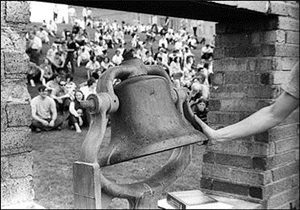
11:45 a.m.
Allison Krause has just completed her final history exam in which she writes:
“Dates and facts are not enough to show what happened in the past when dealing with people. It is necessary to delve into the human side of history to come up with the truth. History must be made relevant to the present to make it useful.”
As the class break occurs at Kent State, many more students pour on to the Commons. General Robert Canterbury of the National Guard notices the increasing number of students and assumes they all are gathering to participate in the scheduled rally. He orders the group to disperse immediately.
The message is communicated via a mechanical speaker and is not heard by many members of the crowd. Those who do hear the message express anger. Prior to this announcement, there has been no violence. Rocks and obscenities are now directed at the Guard.
11:55 a.m.
Some students begin to ring the victory bell. Most of those present are standing on the edge of the Commons watching the Guard and the two hundred students near the victory bell. General Canterbury orders the Guardsmen to disperse the crowd. The Guardsmen are equipped with loaded M-1 rifles and ample tear gas supplies.
Noon
Tear gas canisters are exploded among the students, but wind conditions limit their effectiveness.
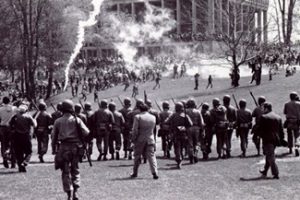
The Guard continues its march across the Commons area. As the crowd of students scatter up Blanket Hill, many shout obscenities and hurl objects at the Guard.
12:10 p.m.
The Guardsmen head up Blanket Hill to a field where they are met by a chain-link fence. For approximately ten minutes the Guard stays in this position, apparently confused as to their next move.
During this time tear gas canisters are thrown back and forth from the Guard’s position to a small group of students located in the Prentice Hall parking lot. The majority of students are located in front of Taylor Hall to the Guard’s left.
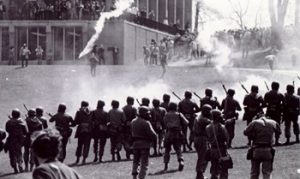
12:20 p.m.
Realizing there is confusion among the Guard located on the practice field, Major Harry Jones walks through the crowd of students observing the Guard near Taylor Hall.
Several members of the Guard kneel and aim their weapons at the approximately twenty-five students in the Prentice Hall parking lot.
Although they don’t open fire at this point, a subsequent Justice Department investigation determines that “one person, however, probably an officer, at this point did fire a pistol in the air. No guardsman admits firing this shot.”
The day after the shootings, a spent .22-caliber casing was found near the edge of the field. Since only Major Jones carried such a weapon, this casing likely came from his gun although he never admitted firing a shot.
Canterbury concludes that the crowd has been dispersed and orders the Guard to march back to the Commons area. Most of the students believe the action to be over and begin walking away from the area. Some continue to shout obscenities and throw rocks at the Guard.
Jeffrey Miller, moments before he is shot and killed
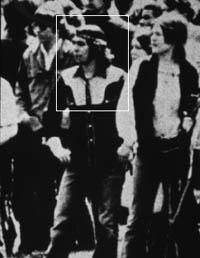
Sandy Scheuer, moments before she is shot and killed
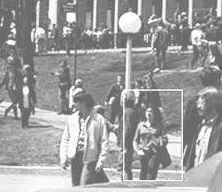
Allison Krause, moments before she is shot and killed
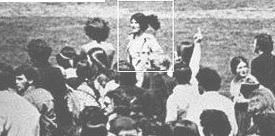
Bill Schroeder, moments before he is shot and killed
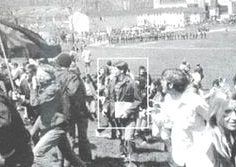
12:24 p.m.
As the Guard reaches the crest of Blanket Hill near the Pagoda of Taylor Hall, a group of Guardsmen suddenly turn around 135 degrees, walk back a few steps and fire their weapons into the group located in the parking lot.
67 shots in 13 seconds.
Alan Canfora just before he was shot in the wrist
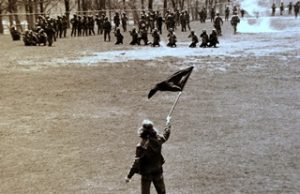
Various professors are successful in preventing further bloodshed. Most notable of the professors is Glenn Frank who makes a passionate plea to a group of students who have no intention of leaving the area.
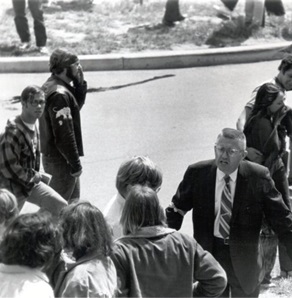
“I don’t care whether you’ve never listened to anyone before in your lives. I am begging you right now. If you don’t disperse right now, they’re going to move in and it can only be a slaughter. Would you please listen to me? Jesus Christ, I don’t want to be a part of this!”
HEAR GLENN FRANK’S PLEA
Almost immediately after the shootings, the guardsmen claim they fired in response to a sniper. Although the sniper theory is quickly abandoned and never thoroughly investigated, evidence exists to suggest that someone other than a guardsman may indeed have fired a weapon.
As the Guard marches back to their original position, a young man carrying a gun, a camera, and a gas mask ran over the hill, pursued by another person, yelling, “Stop that man. He has a gun. He fired four shots.”
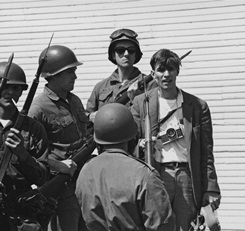
The mysterious Terry Norman
Stopping at the guard line, photographer Terry Norman is quickly surrounded by the Kent State police. KSU policeman Tom Kelly takes possession of Norman’s gun, a .38-caliber Smith & Wesson revolver. NBC reporter Fred DeBrine hears the policeman exclaim, “My God, he fired four shots! Later, however, Kelly claims that Norman’s gun was “fully loaded” and “had not been fired.” In any case, the KSU policemen quickly hustle Norman away from the scene.
It will take three years before FBI director Clarence Kelley finally admits Terry Norman had indeed been on the FBI payroll.
Afternoon
Portage County Prosecutor Ronald Kane orders the school closed.
AFTERMATH
In the weeks following the shootings, William Schroeder’s parents were the victims of almost unspeakable hate mail. It is important to remember that William was not a demonstrator the day he was killed (nor was Sandy Scheuer).
In fact, William was a recipient of a United States Army R.O.T.C. Four-Year Scholarship. He had decided that the presence of a trained psychologist on the military front could be as important as the soldier’s rifle or the chaplain. He had hoped to attend Graduate School for further training before going on active duty. His accumulative average was 3.28 for the two quarters at Kent, and he expected even better grades for the Spring Quarter.
And yet, some twisted minds chose to spew their venom at his parents in this manner:
“Mr and Mrs Schroeder,
There’s nothing better that a dead destructive, riot making communist, and that’s what your son was, if not he would have stayed away like a good American would do.
Now you know what a goody-goody son you had.
They should all be shot, then we’d have a better U.S.A. to live in.
Be thankful he is gone, Just another communist.”
Prominent businessmen and citizens of Kent purchased an advertisement in the Kent Record Courier, declaring
THANK YOU GENERAL DEL CORSO AND THE NATIONAL GUARD
The Mayor of Kent praised the actions of the National Guard during their stay in Kent, and some expressed the thought that “more should have been killed and that when trouble-makers have long hair, use bad language and go barefoot and even destroy property, they have to be stopped.”
Governor James Rhodes went on to lose his senatorial election by less than one percent of the total vote, but a poll taken one week prior to the shootings had suggested a disastrous defeat for him. By all accounts, his popularity somehow surged following the shootings.
In October 1974, after numerous delays, the criminal trial of eight guardsmen – some of whom faced a maximum sentence of life imprisonment if convicted – began in Cleveland.
Despite clear evidence that the National Guard had fired in offense, (rather than defense) derived from over one thousand pages of FBI reports, countless eye-witness testimonies and a through investigation by local, state and federal authorities, the courts ultimately blamed the student protesters.
The Report of the Special Grand Jury under Judge Edwin W. Jones concluded, “We find…that those members of the National Guard who were present on the hill adjacent to Taylor Hall on May 4, 1970 fired their weapons in the honest and sincere belief that they would suffer serious bodily injury had they not done so. They are not, therefore, subject to criminal prosecution under the laws of this state from any death or injury resulting therefrom.”
In transcripts obtained from the 1975 Cleveland Federal Court civil lawsuit against Rhodes and the Ohio National Guard, Governor Rhodes admitted under oath that he had twice committed perjury in earlier trials regarding two telephone conversations he had with President Nixon in the days prior to the shootings. The topic of their conversations, as Rhodes finally admitted, was the Kent State anti-war students’ militant actions on May 1 and May 2.
Whatever the reasons behind the massacre, be it an attack planned and carried out by the government or a matter of confused National Guardsmen, there is one inescapable truth which remains painfully true fifty years later.
Nine Were Wounded
Joseph Lewis, Jr.
70 feet away, shot in the abdomen and lower leg
John Cleary
110 feet away, shot in the chest
Tom Grace
225 feet away, shot in the foot
Alan Canfora
225 feet away, shot through his wrist
Dean Kahler
300 feet away, shot in the back and permanently paralyzed
Douglas Wrentmore
329 feet away, shot in his knee
Jim Russell
375 feet away, shot in the thigh and forehead
Robbie Stamps
495 feet away, shot in the right buttock
Donald Scott MacKenzie
750 feet away, shot in the neck
And … There Were Four Dead In Ohio
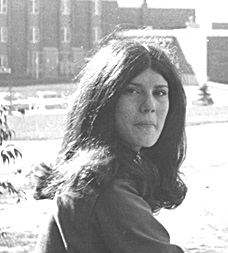
Allison Krause … 19 (Shot in left side of her chest – 343 feet from the soldiers – she dies en route to the hospital)
More of a listener than a talker; she never preached about her deeply held views. She opposed the war, and with her boyfriend, Barry Levine, was among the spectators caught in the rifle fire. An honor student interested in the history of art, she believed in protest but not in violence.

Sandy Scheuer … 20 (Shot in the neck – 390 feet from the soldiers – she bleeds to death in the parking lot … It is her parents’ 27th wedding anniversary)
A junior from Youngstown, Ohio, she was walking to a speech therapy (her major) class when she was caught in the fusillade of bullets. A bubbly girl and honor student, she had virtually no interest in politics or protest.
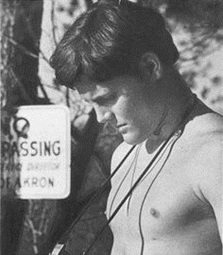
Bill Schroeder … 19 (Shot in the left side of his chest – 382 feet from the soldiers – he survives the trip to the hospital but dies as he is being wheeled into an operating room)
A psychology major from Lorain, Ohio, he was the second-ranking student in Kent State’s Army ROTC unit. A former Eagle Scout, high school basketball and track standout, he was the image of the clean-cut, academically conscientious Middle American boy.
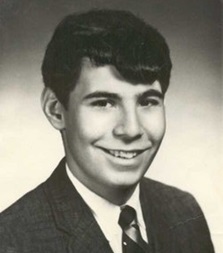
Jeffrey Miller … 20 (Shot in the mouth – 265 feet from the soldiers – he dies instantly)
A transfer student from Michigan State, he wore his hair long, liked bell bottoms, love beads and rock music, but he was no militant activist.
“I know it sounds like a mother,” said Mrs. Elaine Miller, “but Jeff didn’t want to go to war, not because he’d be hurt, but because he might have to hurt someone else.”
AFTERMATH – PART II
During a May 8 press conference, President Nixon was asked about the shootings…
A bizarre moment took place at 5:00 a.m. on May 9, during which Nixon made an impromptu visit to the Lincoln Memorial and engaged in a rambling dialogue with student protestors.
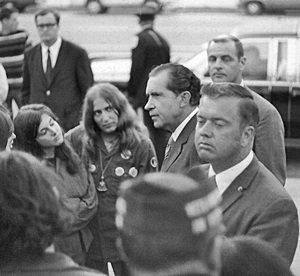
“I hope that [your] hatred of the war, which I could well understand, would not turn into a bitter hatred of our whole system, our country and everything that it stood for. I said that I know probably most of you think I’m an SOB. But I want you to know that I understand just how you feel.”
When several of the students said they attended Syracuse University, Nixon commented on how good the school’s football team was. Far from being overawed, the students found Nixon’s behavior as downright bizarre.
“I hope it was because he was tired but most of what he was saying was absurd,” one of the Syracuse students told the press afterwards. “Here we had come from a university that’s completely uptight, on strike, and when we told him where we were from, he talked about the football team.”
H.R. Haldeman, who worked more closely with Nixon than anyone in the administration, confided in his diary later that day, “The (Cambodia) decision, the speech, the aftermath killings (at Kent State), riots, the press conference, the student confrontation (at the Lincoln Memorial) have all taken their toll, and he has had very little sleep for a long time and his judgment, temper, and mood suffer badly as a result. There’s a long way to go, and he’s in no condition to weather it.”
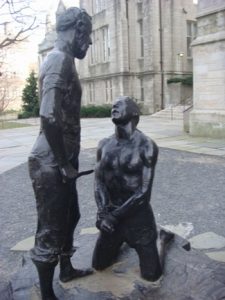
On the campus of Princeton University, between the library and the Chapel, is American George Segal’s ‘Abraham and Isaac: In Memory of May 4, 1970, Kent State University’. The 81-inch bronze was installed in 1979 after it was turned down by Kent State. Though Abraham looks poised to strike his son, the artist emphasized that Genesis 22: 10-13 ends without tragedy, as Isaac was spared.
THE FINAL WORD
Ray Lemire ©2011-2020 RayLemire.com. / Streamingoldies.com. All Rights Reserved.
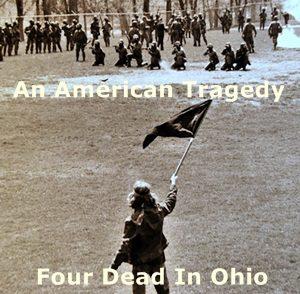
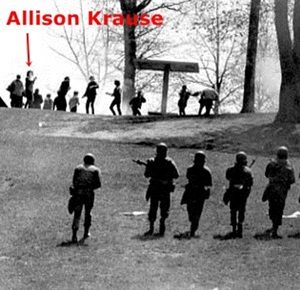
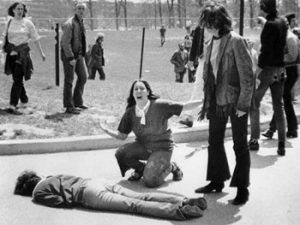
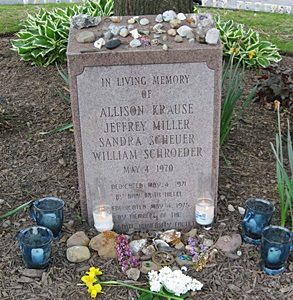
This was one of the most disturbing articles I have ever read. The brutality was bad enough but the failure to hold the guilty parties accountable was even worse.
I have to wonder how long it took you to put this all together. However long it was, you need to know your work is appreciated. It has always been appreciated.
I am going to miss your lessons very much but I understand you need a break from all of it. Good luck!
Thank you, Dan.
I have sincerely been grateful for your comments and encouragement.
As I read through this piece I could feel your pain Ray and I felt pain (as well as shame and disgust) too… I remember the Kent State tragedy … and I’ve read your posts on the disaster that took place there on this date in years past. The event itself was tragic … the reaction by politicians, college officials, the national guard, and the local police was horrific… of course the students were angry .. they didn’t feel their country leaders were not listening to them … they were watching their friends go off to fight a war that wasn’t declared and that they didn’t believe in … and many were not coming home … it was a time of terrible unrest in our country – as our music still reveals … and as is all too common innocent people died on that day …
Thank you Ray for all of your history lessons. You have done a phenomenal job of trying to show us our past and help us learn from our mistakes instead of repeating them … all to make our world a better place. There are many of us that will miss your daily posts … maybe from time to time you could “pop in” for a lesson or two. You are an outstanding caring and kind man and I am glad to call you my friend. Do take care, stay well and Rock Every Day … hugs and much love
Thank you so much, Barbara.
It has been a blessing having you as a “student” but I am even more grateful having you as a friend. When the final article pops up later today, your name will of course be mentioned, along with several others who inspired me to continue long after I intended to stop.
Several things have occurred lately, though, that made my decision to stop now a little easier. I recently turned 70 (not a death sentence, but still…) and a dramatic drop in readers. I decided months ago that I would rather “go out on top” rather than becoming completely insignificant.
Thank you for everything … and … ROCK THE SUMMER!
Ray I remember this day like it was yesterday!! I was working on Valley St.@ Barlow’s Hardware store!! My co worker and I heard the news about the shootings we were in total shock!! We were talking about it and in came a customer who heard us talking about it and one of us asked what he thought about the situation!! This man went ballistic about us hippy mother fuckers and said they should have shot them all!! He came after me and I stopped him before he could hurt me!! Long story short both my co-worker and I were sent down to the basement to cool down!! We did not want to lose our jobs so we did not talk about it anymore!! Us Hippies were in the wrong!! To this day I can’t believe this happened!! Riots do get out of control however to open fire on kids with no wepons is crazy!! The older crowd seemed to think it was ok!! You can always get more from honey than you can from vinegar!! Have a great time off!!
Thanks, Fred.
For starters, I had no idea you worked at BK Barlow’s. I did too in the summer/fall of 1969 as a truck driver delivery guy. I think the manager’s name was Don Estey but I may be wrong. It was a long time ago.
Now, as for Kent State, the reaction you got from the customer was all too typical of the era. Anyone with long hair (or even approaching long hair) was T-R-O-U-B-L-E. Kids running AWAY from the Guard were hardly threatening the soldiers, and gunning down (murdering) innocent students on their way to class was and is bullshit.
Terrible, terrible day in this nation’s history.
Enjoy your summer!
Ray do you remember Ross Hunt?? He worked there and yes it was Don!! I don’t remember when I started work there!!
I remember Ross. He took Bill Slade’s place at Britt’s when Bill joined up with Bill Lashua to start up Bills’ Sight and Sound. I wonder whatever happened to Ross.
Heartbreaking, gut wrenching and horrific. I remember so many elders saying that the kids deserved whatever they got. Kent State’s aftermath, in my opinion, furthered the generation gap for our generation. Instead of claiming we were the best and that all we did was good and right, our generation said wait a minute, things are not as they seem. Don’t believe all they tell you. This wasn’t a riot in the streets, this wasn’t unrest in the inner cities. This was the National Guard under orders firing guns into crowds of college students exerting their right to assembly peacefully and practice freedom of speech. All glossed over by lies to justify their actions.
Thank you Ray for being an historian, we need historians like you to help us remember and to uncover what we didn’t know. If we lose our history, who are we?
Enjoy your retirement, you have earned it. We are at a time in our lives when priorities change.
Our time is waning and we realise what means the most to us. So God bless you and yours, may you make many more memories to fill your life with joy!
Thank you, Donna.
As disillusioned as I had been prior to May 4, it was THIS day that ripped away my innocence, once and forever. I did not know any of The Four, nor did I know any of the wounded, but they all were, in one sense, my brothers and sisters in solidarity, protesting against a war we had no business being part of.
You have been so wonderful with your daily commentaries. I have enjoyed each and every single one of them.
Enjoy Your Summer!
If it’s ok…I am sending you a hug.
It’s more than ok. 🙂
Thank you.
Ray, Thank you for this very good article!
The statements, quotes, fact’s, pictures &
video’s where heartfully laid out. Yes, I
also remember that day & was quite amazed.
Our ‘High School” held a special all school
meeting for everyone, and it was very very
emotional. Kent State is something that none
of us from that time zone will ever forget.
Thank you, Smokey. I appreciate the nice comments.
It certainly was a day from hell … for those students, and for this nation.
There isn’t much I can add to these wonderfully spot-on comments above. Though I wasn’t quite born yet, or truly don’t recall learning about this devastating day in “traditional” school, YOU brought me there with all the details and raw emotions that go along with them.
It is fitting that this event coincides with your last lesson. Partly, because it’s a moment in history that feels like a punch in the gut and brings you right back…even 50 years later. And mostly, because I know how important it has always been to you to keep the past in the present, to never forget.
For all these years, that’s exactly what you have accomplished. Every lesson has been filled (major understatement) with memories and details which should be forever remembered. I also enjoyed how you always mentioned the underdogs or forgotten ones, giving everyone their proper recognition for their place in history. Always.
Your work will live on through this site and through the fond memories of enjoying daily history lessons. History used to be my least favorite subject in school. As a young adult, I didn’t feel knowledgeable and therefore was disengaged from it. It is no bias to say YOU were the one, the only one, who made history interesting and understandable to me.
I feel proud of all I have learned, all I’ve grown to care about and that I have a desire to continue learning and to never let myself forget.
We won’t forget, and personally speaking, that is because you have successfully done your job and shown us how important it is to remember. Now that is our job and responsibility. Thankfully, there are great resources out there and you know which one will be my favorite.
I’m so proud of you Teach, Mr. Lemire, Daddy. You have made your own place in history and don’t you ever doubt that.
I love you so much! XOXOXOXO
Wendyl …
Wow! I know you won’t believe this but I don’t have the words inside me that will allow me the chance to thank you for all that you said.
It is true a lot of the events I covered over the years occurred long before you were born but you expressed such an interest in all of it. THAT compelled me to dig deeper into the background, so I have you to thank for that.
Let me address your feeling of pride, in me and my work. I mean this from the bottom of my heart … You, kiddo, motivated me constantly. You listened to me grumble and you talked me through it each and every time. You assured me that I had to do what was right for me, so when I decided it was time to call it a day, it was YOU I told first because I trusted you would listen and back me up, no questions asked … and you did. You always did.
You may be proud of what I have done here, but I guarantee you there is no one on earth who could be more proud as a parent than I am. I wish I had half of your compassion for others. I wish I had half the patience you possess. I wish you knew (really knew) just how much I love you!
XOXOXOXO
I do know, Daddy…I really do! I’m a lucky daughter who has no doubts about that and proudly sits on her pedestal. After all, I am a Daddy’s Girl. 🙂 Your very sweet reply gave me a few happy tears. We are quite a pair, you and I. We always have been and will continue to be. All my lovin’ to you as you begin this well-deserved transition into retirement. 🙂
Thanks, Wendyl. 🙂
We are very unique. 🙂